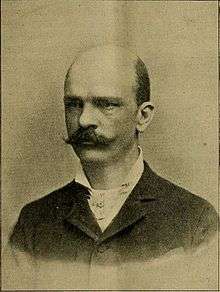Robert Wilson Shufeldt
Robert Wilson Shufeldt (1 December 1850 – 21 January 1934) was an American osteologist, myologist, museologist and ethnographer who contributed to comparative studies of bird anatomy and forensic science.[1] He held strong views on race and was a proponent of white supremacy.[2][3][4] A scandal and subsequent divorce from his second wife, the granddaughter of the famous ornithologist John James Audubon, led to a landmark judgment by the Supreme Court of the United States of America on the subject of alimony and bankruptcy.

Life and career
Son of Admiral Robert Wilson Shufeldt and Sarah Shufeldt, he was born in New York in 1850. After a school education in the United States and Havana, he joined as a Captain's clerk on the US Gunboat USS Proteus which was under the command of his father. In 1872 he joined Cornell University to study medicine and obtained a degree in 1876 from Columbian, Washington DC. He joined the Medical Department of the Army as a Lieutenant and was posted to Fort McHenry. He later worked as a surgeon in the campaign against the Sioux Indians. He retired in 1891 from the army as a Captain but was readmitted and posted on duty in the Army Medical Museum as a curator in 1882. He retired on January 9, 1919 as a surgeon.[1] He was a lifelong member of the Democratic Party and a supporter of Woodrow Wilson.
Scientific contributions
Shufeldt's scientific interests began during his years in surgical practice. He had made zoological and botanical collections and had published extensively on osteology.[1] He became an honorary curator at the Smithsonian Institution in 1882 and held it until 1892.[5]
He published as many as 1,100 notes and books, often on natural history but specializing in anatomy and systematics of birds which included a study of the last passenger pigeon.[1][6][7] He had an interest in fossil birds and contributed to Alfred Newton's A dictionary of birds (1893-96). He is credited with coining the word "paleopathology", the study of diseases and cause of death of decomposed specimens.[4] He also took a great interest in the field of photography, using it to document birds[8] as well as human anatomy.[9] He published a report on taxidermy[10][11] and a book Studies of the human form for artists, sculptors and scientists (1908) which included many nude photographs.[4] He was also a collector of skeletons and was known to have dug up the graves of many Indian tribes.[4][12]
Shufeldt brought the work of Gerhard Heilmann, written in Danish, to the attention of American researchers.[13]
Personal life
Shufeldt married three times, first to Catherine Babcock, then to Florence Audubon (granddaughter of John James Audubon) before marrying Alfhild Dagny Lowum, a Norwegian.[1] The first wife Catherine committed suicide in an asylum. His second wife, Florence Audubon, left him after two months of marriage accusing him of adultery. Florence sought divorce on the grounds that Robert was having an affair with their Norwegian housekeeper, who would later become his third wife. Around this time he published a pamphlet titled On female impotency[14] which included a photograph of a nude woman who he described as a mulatto but likely Ms. Audubon. This paper describing his personal problems, thinly veiled as medical research and meant to blackmail Florence, stated his affiliation to the Smithsonian Institution which outraged the Smithsonian leadership and led to his dismissal in 1897. Shufeldt refused to pay alimony following the divorce and claimed bankruptcy which was taken up in the US Supreme Court "Audubon v. Shufeldt, 181 US 575(1901)".[15] He took back many of the specimens that he had collected for the Smithsonian and later deposited them with the New York State Museum. Other organizations like the AOU also attempted to distance themselves due to the potential for scandal and shame.[16]
Shufeldt had two sons from his first wife Catherine. Robert (1877–1892), who was interested in ornithology, died while collecting specimens for Marietta College. Family oral history, however, called this a hazing incident. Percy (1879–1949) briefly attended Marietta College as well, and became a successful harvester and trader of chicle. A daughter, Catherine, died of diphtheria in childhood. A foster daughter was listed in the 1881 census as a nurse.[4]
References
- Lambrecht, K (1935). "In memoriam: Robert Wilson Shufeldt, 1850–1934" (PDF). The Auk. 52 (4): 359–361. doi:10.2307/4077508.
- Shufeldt, Robert W. (1915). America's Greatest Problem: The Negro. Philadelphia: FA Davis.
- Shufeldt, RW (1907). The Negro. A menace to American civilization. Gorham Press.
- Cook, Della Collins (2012). "Neglected Ancestors: Robert Wilson Shufeldt, MD (1850–1934)". In Buikstra J & C Roberts (ed.). The Global History of Paleopathology: Pioneers and Prospects. Oxford University Press. pp. 192–196.
- Johnston, David W. (2003). The History of Ornithology in Virginia. University of Virginia. p. 73.
- Shufeldt, R.W. (1914). "Osteology of the Passenger Pigeon (Ectopistes migratorius)". Auk. 31: 358–362. doi:10.2307/4071953.
- Shufeldt, R.W. (1915). "Anatomical and Other Notes on the Passenger Pigeon (Ectopistes migratorius) Lately Living in the Cincinnati Zoölogical Gardens". Auk. 32: 29–41. doi:10.2307/4071611.
- Shufeldt, R.W. (1906). "Bird photography in Norway". Popular Science Monthly: 464–472.
- Shufeldt, RW (1891). "Where Young Amateur Photographers can be of Assistance to Science". The American Naturalist. 25: 626–630. doi:10.1086/275362.
- Shufeldt, RW (1892). Scientific taxidermy for museums. Report of US National Museum. US National Museum. p. 369.
- Shufeldt, R.W. (1917). "Taxidermy as an art". Art World: 210–214.
- Shufeldt, R. W. (1910). "Personal Adventures of a Human Skull Collector". Medical Council. 15 (4): 123–27.
- Shufeldt, R.W. (1914). "Researches of Gerhard Heilmann on the Origin of Birds". Auk. 31: 287–289. doi:10.2307/4071772.
- On the medico-legal aspect of impotency in women. Read before the Medico-Legal Society.
- Aigler, Ralph W. (1912). "Provability in Bankruptcy of Claims Arising out of Alimony Decrees or Separation Agreements between Husband and Wife". Mich. L. Rev. 10: 476–478.
- Barrow Jr., Mark V. (1998). A Passion for Birds. Princeton, New Jersey: Princeton University Press. pp. 63–67.
External links
| Wikimedia Commons has media related to Robert Wilson Shufeldt. |